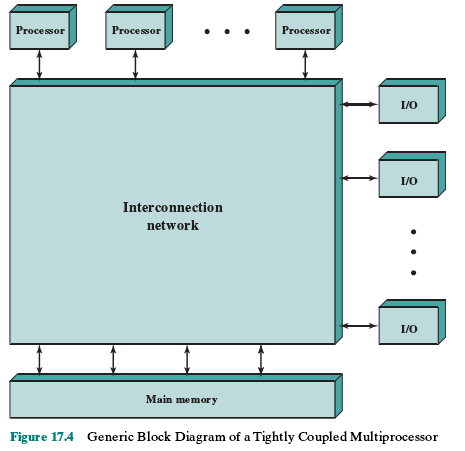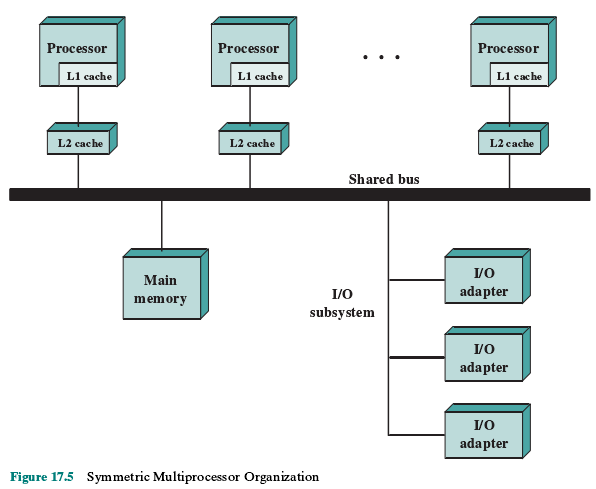Organization SYMMETRIC MULTIPROCESSORS
COMPUTER ORGANIZATION AND ARCHITECTURE DESIGNING FOR PERFORMANCE NINTH EDITION

Figure 17.4 depicts in general terms the organization of a multiprocessor system.
There are two or more processors. Each processor is self-contained, including a
control unit, ALU, registers, and, typically, one or more levels of cache. Each pro-
cessor has access to a shared main memory and the I/O devices through some form
of interconnection mechanism. The processors can communicate with each other
through memory (messages and status information left in common data areas). It
may also be possible for processors to exchange signals directly. The memory is
often organized so that multiple simultaneous accesses to separate blocks of mem-
ory are possible. In some configurations, each processor may also have its own pri-
vate main memory and I/O channels in addition to the shared resources.
The most common organization for personal computers, workstations, and
servers is the time-shared bus. The time-shared bus is the simplest mechanism for
constructing a multiprocessor system (Figure 17.5). The structure and interfaces are
basically the same as for a single-processor system that uses a bus interconnection.
The bus consists of control, address, and data lines. To facilitate DMA transfers
from I/O subsystems to processors, the following features are provided:
• Addressing: It must be possible to distinguish modules on the bus to deter-
mine the source and destination of data.
• Arbitration: Any I/O module can temporarily function as “master.” A mecha-
nism is provided to arbitrate competing requests for bus control, using some
sort of priority scheme.
• Time-sharing: When one module is controlling the bus, other modules are
locked out and must, if necessary, suspend operation until bus access is achieved.
hese uniprocessor features are directly usable in an SMP organization. In
this latter case, there are now multiple processors as well as multiple I/O processors
all attempting to gain access to one or more memory modules via the bus.

The bus organization has several attractive features:
• Simplicity: This is the simplest approach to multiprocessor organization. The
physical interface and the addressing, arbitration, and time-sharing logic of
each processor remain the same as in a single-processor system.
• Flexibility: It is generally easy to expand the system by attaching more proces-
sors to the bus.
• Reliability: The bus is essentially a passive medium, and the failure of any
attached device should not cause failure of the whole system.
The main drawback to the bus organization is performance. All memory ref-
erences pass through the common bus. Thus, the bus cycle time limits the speed
of the system. To improve performance, it is desirable to equip each processor
with a cache memory. This should reduce the number of bus accesses dramatically.
Typically, workstation and PC SMPs have two levels of cache, with the L1 cache
internal (same chip as the processor) and the L2 cache either internal or external.
Some processors now employ a L3 cache as well.
The use of caches introduces some new design considerations. Because each
local cache contains an image of a portion of memory, if a word is altered in one
cache, it could conceivably invalidate a word in another cache. To prevent this, the
other processors must be alerted that an update has taken place. This problem is
known as the cache coherence problem and is typically addressed in hardware rather
than by the operating system. We address this issue in Section 17.4.
Organization SYMMETRIC MULTIPROCESSORS的更多相关文章
- SYMMETRIC MULTIPROCESSORS
COMPUTER ORGANIZATION AND ARCHITECTURE DESIGNING FOR PERFORMANCE NINTH EDITION As demands for perfor ...
- Multiprocessor Operating System Design Considerations SYMMETRIC MULTIPROCESSORS
COMPUTER ORGANIZATION AND ARCHITECTURE DESIGNING FOR PERFORMANCE NINTH EDITION An SMP operating syst ...
- parallelism
COMPUTER ORGANIZATION AND ARCHITECTURE DESIGNING FOR PERFORMANCE NINTH EDITION Traditionally, the co ...
- Massively parallel supercomputer
A novel massively parallel supercomputer of hundreds of teraOPS-scale includes node architectures ba ...
- QEMU中smp,socket,cores,threads几个参数的理解
在用QEMU创建KVM guest的时候,为了指定guest cpu资源,用到了-smp, -sockets, -cores, -threads几个参数, #/usr/bin/qemu-system- ...
- c++多线程同步使用的对象
线程的同步 Critical section(临界区)用来实现“排他性占有”.适用范围是单一进程的各线程之间.它是: · 一个局部性对象,不是一个核心对象. · 快速而 ...
- 第4章 同步控制 Synchronization ----同步机制的摘要
同步机制摘要Critical Section Critical section(临界区)用来实现"排他性占有".适用范围是单一进程的各线程之间.它是: 一个局部性对象,不是一个核 ...
- 线程的同步控制(Synchronization)
临界区(Critical Sections) 摘要 临界区(Critical Section) 用来实现"排他性占有".适合范围时单一进程的各线程之间. 特点 一个局部对象,不是一 ...
- 分布式计算课程补充笔记 part 1
▶ 高性能计算机发展历程 真空管电子计算机,向量机(Vector Machine),并行向量处理机(Parallel Vector Processors,PVP),分布式并行机(Parallel Pr ...
随机推荐
- word如何插入目录
word如何插入目录 百度经验:jingyan.baidu.com 在写文章的时候我们需要插入目录,如果自己手动添加目录会非常麻烦,以后修改文章的时候还得修改目录的页码,还好Word中有自动添加目录的 ...
- 水平时间轴 html + css
比较粗糙,效果如图 这个是写微信页面时写的,pc 也是一样的效果 代码如下: <div class="time_line_box"> <div class=&qu ...
- Ubuntu 14.4 配置
1.安装 Orcal Java 使用下面的命令安装,只需一些时间,它就会下载许多的文件,所及你要确保你的网络环境良好: sudo add-apt-repository ppa:webupd8team/ ...
- manven搭建和ssm的整合(转)
原文:http://www.cnblogs.com/youzhibing/p/5004619.html 这是个很好的帖子,但是原文的maven搭建上有点问题. 帖子后面有说,其实不用配环境变量也是可以 ...
- 浅析session&cookie
session&cookie没有出现的黑暗时代 大家都知道,HTTP协议是一种无状态的协议,本次请求下一次请求没有任何的关联,所有没有办法直接用http协议来记住用户的信息,试想一向,每一次点 ...
- Java 初学记录之可执行jar包
环境 jdk7 jre7 当我用jdk7开发的时候,编写完成可执行的jar工具,并且成功使用. 当我在另一台机器安装了jre6,再次运行我的小工具jar 的时候,报错 解决: http://stack ...
- [MongoDB]MongoDB的优缺点及与关系型数据库的比较
汇总: 1. [MongoDB]安装MongoDB2. [MongoDB]Mongo基本使用:3. [MongoDB]MongoDB的优缺点及与关系型数据库的比较4. [MongoDB]MongoDB ...
- Mac系统 安装SVN
- Deep Learning模型之:CNN卷积神经网络(一)深度解析CNN
http://m.blog.csdn.net/blog/wu010555688/24487301 本文整理了网上几位大牛的博客,详细地讲解了CNN的基础结构与核心思想,欢迎交流. [1]Deep le ...
- html标签思维导图
